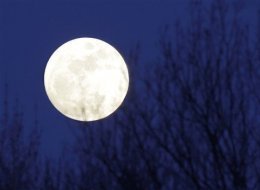 I read the other day that the full moon this past Friday (it looked pretty full last night too) was the brightest full moon of the year. We were talking last night and no one knew why it would be the brightest. Turns out it has to do with the perigee of the moon (closest point to earth) coinciding with the full phase of the moon...or something like that.
I read the other day that the full moon this past Friday (it looked pretty full last night too) was the brightest full moon of the year. We were talking last night and no one knew why it would be the brightest. Turns out it has to do with the perigee of the moon (closest point to earth) coinciding with the full phase of the moon...or something like that.While that's interesting, what I found more interesting is that Native American tribes named each full moon. For the Algonquin tribes, the full moon in January is called the Full Wolf Moon because "Amid the zero cold and deep snows of midwinter, the wolf packs howled hungrily outside Indian villages", according to Space.com.
Here's a list of the remaining full moons this year and their Native American names...
Full Moon names date back to Native Americans, of what is now the northern and eastern United States. Those tribes of a few hundred years ago kept track of the seasons by giving distinctive names to each recurring full moon. Their names were applied to the entire month in which each occurred.
Feb. 28, 11:38 a.m. EST -- Full Snow Moon. Usually the heaviest snows fall in this month. Hunting becomes very difficult, and hence to some tribes this was the Full Hunger Moon.
Mar. 29, 10:25 p.m. EDT -- Full Worm Moon. In this month the ground softens and the earthworm casts reappear, inviting the return of the robins. The more northern tribes knew this as the Full Crow Moon, when the cawing of crows signals the end of winter, or the Full Crust Moon because the snow cover becomes crusted from thawing by day and freezing at night. The Full Sap Moon, marking the time of tapping maple trees, is another variation.
Apr. 28, 8:18 a.m. EDT -- Full Pink Moon. The grass pink or wild ground phlox is one of the earliest widespread flowers of the spring. Other names were the Full Sprouting Grass Moon, the Egg Moon, and -- among coastal tribes -- the Full Fish Moon, when the shad come upstream to spawn.
May 27, 7:07 p.m. EDT -- Full Flower Moon. Flowers are now abundant everywhere. It was also known as the Full Corn Planting Moon or the Milk Moon.
Jun. 26, 7:30 a.m. EDT -- Full Strawberry Moon. Strawberry picking season peaks during this month. Europeans called this the Rose Moon.
Jul. 25, 9:37 p.m. EDT -- Full Buck Moon, when the new antlers of buck deer push out from their foreheads in coatings of velvety fur. It was also often called the Full Thunder Moon, thunderstorms being now most frequent. Sometimes it's also called the Full Hay Moon.
Aug. 24, 1:05 p.m. EDT -- Full Sturgeon Moon, when this large fish of the Great Lakes and other major bodies of water like Lake Champlain is most readily caught. A few tribes knew it as the Full Red Moon because when the moon rises it looks reddish through sultry haze, or the Green Corn Moon or Grain Moon. Since the Moon arrives at apogee about 12 hours later, this will also be the smallest full moon of 2010. In terms of apparent size, it will appear 12.3-percent smaller than the full Moon of Jan. 30.
Sep. 23, 5:17 a.m. EDT -- Full Harvest Moon. Traditionally, this designation goes to the full moon that occurs closest to the Autumnal (fall) Equinox. The Harvest Moon usually comes in September, but (on average) once or twice a decade it will fall in early October. At the peak of the harvest, farmers can work into the night by the light of this moon. Corn, pumpkins, squash, beans, and wild rice -- the chief Indian staples -- are now ready for gathering.
Oct. 22, 9:36 p.m. EDT -- Full Hunters' Moon. With the leaves falling and the deer fattened, it's now time to hunt. Since the fields have been reaped, hunters can ride over the stubble, and can more easily see the fox, as well as other animals, which can be caught for a thanksgiving banquet after the harvest.
Nov. 21, 12:27 p.m. EST -- Full Beaver Moon. At this point of the year, it's time to set beaver traps before the swamps freeze to ensure a supply of warm winter furs. Another interpretation suggests that the name Beaver Full Moon come from the fact that the beavers are now active in their preparation for winter. It's also called the Frosty Moon.
Dec. 21, 3:13 a.m. EST -- Full Cold Moon. Sometimes this moon is referred to as the Full Long Nights Moon and the term "Long Night" Moon is a very appropriate name because the nights are now indeed long and the Moon is above the horizon a long time. The moment of the Winter Solstice comes just over 15 hours after this full moon, at 6:38 p.m. EST.
No comments:
Post a Comment